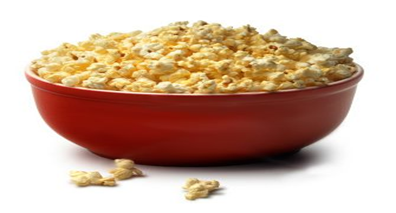STEAMING with STEM: The Science of Popcorn
The Science of Popcorn
Popcorn is one of the world’s favorite snack foods. In the US, Americans consume as much
as 18 billion quarts of popcorn each year, which equates to
56 quarts per person. Some nutritionists call it a perfect snack
food because it is a whole grain, a good source of fiber, and low in fat.
One study even claims there are more antioxidants in popcorn
than in some fruits and vegetables.
Background
The most intriguing part of popcorn is the science behind how it pops. Popcorn is the only grain in the corn family that pops open when exposed to temperatures above 180° C. A popcorn kernel is composed of 3 parts: the pericarp, germ, and endosperm.
The pericarp is the tough outer shell surrounding a popcorn kernel, and the key to what makes it pop. Inside the pericarp is the germ, or seed embryo. Adjacent to the germ is the endosperm, which contains some trapped water plus soft and hard starch granules that serve as food for the germ when it sprouts.
When a popcorn kernel is heated, the trapped water in the endosperm turns into steam, building up pressure inside the pericarp. This pressurized, super-heated steam transforms the soft starch in the endosperm into a gelatinous material. Popcorn pericarp is much stronger than that of all other corn kernels and is able to retain this pressurized steam up to 9.2 atm (135 psi).
Above that pressure, the pericarp ruptures, releasing the steam and gelatinous starch that solidifies upon cooling. The resulting popped kernel is 40 to 50 times its original size. To see popcorn pop in slow motion, https://www.youtube.com/watch?v=ok9qdHZcVIA
People often wonder what is the ideal percentage of water in popcorn kernels for best popping. Popcorn is harvested in the fall when the kernels’ moisture content is between 16 and 20%. The kernels are then stored in bins where they are dried by forced air until reaching an optimum moisture level of 14%. If the moisture content drops below that value, the size of the popped kernels is smaller and the number of kernels that pop decreases.
Pop Pop Pop
Now you know that popcorn is just not a food; it is a science.
You will be exploring how moisture affects popcorn kernels.
There are many factors that can change how popcorn pops,
such as temperature and type of popcorn.
Design Challenge: You’re watching a movie with your friends and you try to replicate that delicious movie theatre popcorn at home. You expect to see big, fluffy kernels when you open the pan, but even after several minutes the popcorn didn’t pop! What gives? You’ve had the popcorn for a while, but you didn’t think popcorn went bad. You notice it looks kind of dried out. Could that be the reason for your failed snack? Being the science expert you are, you decide to investigate with how high, medium, and low levels of moisture affect the popping.
***You must ask your parents before you begin because you will be using a stove and oven.
Materials
- 3/4 cup of popcorn
- Water
- Bowl
- Baking tray
- 9 tablespoons of vegetable oil
- One metal pot with lid
- Ruler
- String
- Thermometer
- Use of a stovetop and oven
Directions
- First, prepare the high moisture popcorn. Take 1/4 cup of popcorn and place it in a bowl or pan. Fill the bowl with water to just barely cover the popcorn. Let soak for 2 hours and remove from the water.
- While that is soaking, prepare your low moisture popcorn. Take 1/4 cup of popcorn and spread it on a baking tray. Bake for 2 hours at 200 degrees Fahrenheit. Baking tray will be hot – use oven mitts when removing tray from the oven. Safety Tip: The oil will get very hot and can splatter. Use caution when adding the popcorn and use oven mitts when touching the pot or lid.
- Normal moisture popcorn would be adding no extra moisture or not drying it out in the oven. In other words, it is right from the bag into the pan. Heat 3 tablespoons of oil on the stove until it reaches about 400 degrees Fahrenheit. Put 1/4 cup of normal moisture popcorn in the pan, put the lid on, and let it pop for about 5 minutes. When the popcorn stops popping for 30 seconds, it’s time to remove the pan from heat. Let the popcorn cool.
- Now, take at least 3 kernels and measure the diameter in centimeters with your ruler. Take a string and wrap it around the kernel, then place it on the ruler to get the diameter measurement in centimeters. Record these in your data table. Take the average of the three kernels’ size and record this in your data table. The more kernels you measure, the more accurate your data will be.
- Repeat steps 3 and 4 for the other types of popcorn: low moisture and high moisture.


